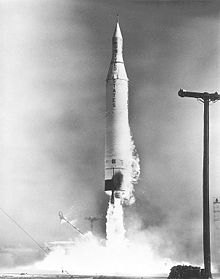Juno II

The Juno-II - rocket went out of the medium-range missile PGM-19 Jupiter forth. This formed the basic level of Juno II and had been extended by 0.91 m for this purpose. A gimbal-mounted Rocketdyne S-3D was used as the engine, which was later used only slightly modified in the Thor . On the first stage, two or three were Sergeant -Feststoffoberstufen that already in the I Juno were used. After the first stage had burned out (182 s after takeoff), these were ignited by a radio pulse from the control center, which caused the Explorer S-46 to be lost due to radio interference . The variant with only two upper stages was used only once for the unsuccessful launch of the Beacon-2 satellite.
The Juno II was launched exclusively from Cape Canaveral between 1958 and 1961 . Out of a total of ten starts, only four were successful.
Rockets of this type transported two Pioneer moon probes (one false start due to premature burnout of the first stage), seven Explorer satellites (four false starts) and one beacon satellite (false start).
The Juno II could carry 41 kg in low earth orbit or 6 kg in interplanetary orbit. Due to their poor performance, no further development of this type of missile took place.
Technical specifications
| Juno-2 | |||
|---|---|---|---|
| length | 23.85 m | ||
| diameter | 2.67 m | ||
| Takeoff mass | 55.0 t | ||
| stages | 4th | ||
| 1st stage | |||
| Engine | North American Rocketdyne LR-79-NA-9 | ||
| Start thrust | 667.2 kN | ||
| fuel | Kerosene and LOX | ||
| Burn time | 182 s | ||
| Takeoff / empty mass | 54.43 / 4.53 t | ||
| length | 18.38 m | ||
| diameter | 2.67 m | ||
| 2nd stage | |||
| Engine | 11 Thiokol baby sergeant | ||
| thrust | 73.4 kN | ||
| fuel | TPH | ||
| Takeoff / empty mass | 327/90 kg | ||
| Burn time | 6.5 s | ||
| length | 1.07 m | ||
| diameter | 1.22 m | ||
| 3rd stage | |||
| Engine | 3 Thiokol baby sergeant | ||
| thrust | 24.0 kN | ||
| fuel | TPH | ||
| Takeoff / empty mass | 94/28 kg | ||
| Burn time | 6.5 s | ||
| length | 1.07 m | ||
| diameter | 1.22 m | ||
| 4th stage | |||
| Engine | 1 Thiokol baby sergeant | ||
| thrust | 8.0 kN | ||
| fuel | TPH | ||
| Takeoff / empty mass | 27/5 kg | ||
| Burn time | 6.5 s | ||
| length | 1.07 m | ||
| diameter | 1.22 m | ||
Start list
This is a complete launch list for the Juno II missile.
| Serial No. | Date ( UTC ) | Ser.-No. | stages | Launch site | payload | Type of payload | Payload in kg (gross 1 ) | Orbit 2 | Remarks |
|---|---|---|---|---|---|---|---|---|---|
| 1 | December 6, 1958 | AM-11 | 4th | CC LC-5 | Pioneer 3 | Probe to fly by the moon | 5.9 kg | Rises before at 102,200 km height it falls back and after 38 hours burn up | Partial success First stage switched off too early. |
| 2 | March 3, 1959 | AT THE 14TH | 4th | CC LC-5 | Pioneer 4 | Probe to fly by the moon | 5.9 kg | Heliocentric | success |
| 3 | July 16, 1959 | AT 16 | 4th | CC LC-5 | Explorer S-1 | Research satellite | 42 kg | planned: LEO | Failure to lose control of the missile after about 5 seconds. |
| 4th | August 14, 1959 | AM-19B | 3 | CC LC-26B | Beacon 2 | Balloon satellite | 5 kg | planned: LEO | Failure First stage shut down too soon. No control over the upper levels. |
| 5 | October 13, 1959 | AM-19A | 4th | CC LC-5 | Explorer 7 (S-1a) | Research on cosmic rays | 42 kg | LEO | success |
| 6th | March 23, 1960 | AM-19C | 4th | CC LC-26B | Explorer (8) (S-46) | Exploration of the radiation belt | 16 kg? | planned: LEO | Failure defect in the second stage. Third stage did not ignite, loss of contact with the ground station. |
| 7th | November 3, 1960 | AM-19D | 4th | CC LC-26B | Explorer 8 (S-30) | Ionospheric research | 41 kg | LEO | success |
| 8th | February 25, 1961 | AM-19F | 4th | CC LC-26B | Explorer (10) (S-45) | Ionospheric research | 34 kg | planned: LEO | Third stage failure did not ignite. |
| 9 | April 27, 1961 | AM-19E | 4th | CC LC-26B | Explorer 11 (S-15) | Gamma ray research | 37 kg | LEO | success |
| 10 | May 24, 1961 | AM-19G | 4th | CC LC-26B | Explorer (12) (S-45a) | Ionospheric research | 34 kg | planned: LEO | Second stage failure failed. |
Web links
- Juno II in the Encyclopedia Astronautica (English)

